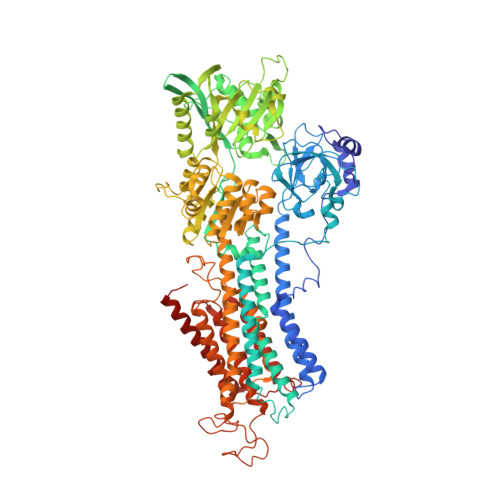The SERCA residue Glu340 mediates interdomain communication that guides Ca 2+ transport.
Geurts, M.M.G., Clausen, J.D., Arnou, B., Montigny, C., Lenoir, G., Corey, R.A., Jaxel, C., Moller, J.V., Nissen, P., Andersen, J.P., le Maire, M., Bublitz, M.(2020) Proc Natl Acad Sci U S A 117: 31114-31122
- PubMed: 33229570
- DOI: https://doi.org/10.1073/pnas.2014896117
- Primary Citation of Related Structures:
6RB2 - PubMed Abstract:
The sarco(endo)plasmic reticulum Ca 2+ -ATPase (SERCA) is a P-type ATPase that transports Ca 2+ from the cytosol into the sarco(endo)plasmic reticulum (SR/ER) lumen, driven by ATP. This primary transport activity depends on tight coupling between movements of the transmembrane helices forming the two Ca 2+ -binding sites and the cytosolic headpiece mediating ATP hydrolysis. We have addressed the molecular basis for this intramolecular communication by analyzing the structure and functional properties of the SERCA mutant E340A. The mutated Glu340 residue is strictly conserved among the P-type ATPase family of membrane transporters and is located at a seemingly strategic position at the interface between the phosphorylation domain and the cytosolic ends of 5 of SERCA's 10 transmembrane helices. The mutant displays a marked slowing of the Ca 2+ -binding kinetics, and its crystal structure in the presence of Ca 2+ and ATP analog reveals a rotated headpiece, altered connectivity between the cytosolic domains, and an altered hydrogen bonding pattern around residue 340. Supported by molecular dynamics simulations, we conclude that the E340A mutation causes a stabilization of the Ca 2+ sites in a more occluded state, hence displaying slowed dynamics. This finding underpins a crucial role of Glu340 in interdomain communication between the headpiece and the Ca 2+ -binding transmembrane region.
- Department of Biochemistry, University of Oxford, OX1 3QU Oxford, United Kingdom.
Organizational Affiliation:



















